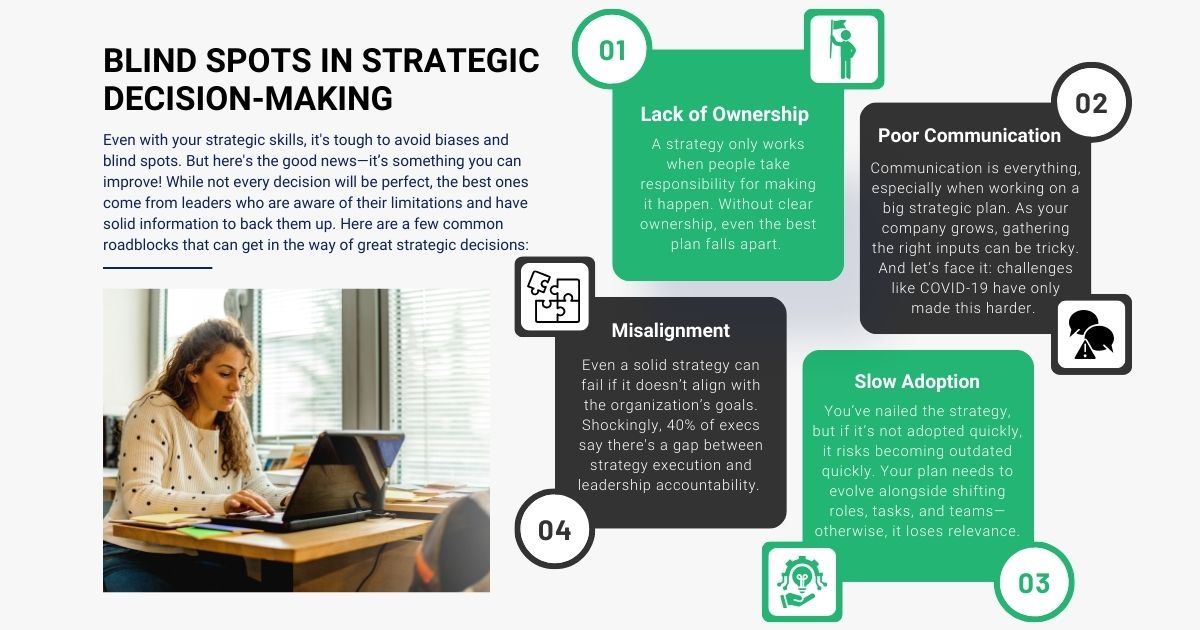
Ever had to make a tough call that could either make or break your business? Have you wondered if your decisions are correct? That is what strategic decision-making is all about—making smart choices when it counts. Whether managing IT operations, making new software investments, or forecasting your organization's growth and progress, your decisions can lead to success—or cause problems. Imagine missing out on a huge opportunity or burning through resources because of one wrong choice. So, how do you improve at making these big decisions as a chief information officer (CIO)? How can you avoid the pitfalls that come with bad choices?
Think about it this way—projects are the building blocks of any organization’s progress. For you, every project is a chance to test new strategies, make bold moves, and steer the company in the right direction. But here’s the thing: you don’t always have a crystal ball to tell you what’ll work and what won’t. That’s where the modern technology solutions like predictive project management come into play. They take the guesswork out of decision-making by giving you real-time insights and forecasts. It's like having a reliable guide that shows you the potential roadblocks ahead so you can adjust your path before it’s too late. This way, you’re not just making decisions—you’re making smart, informed decisions that keep you ahead of the game.
This article explores the concept of strategic decision-making for CIOs, its rising influence, the need for a data-driven culture, potential blind spots, and some real-world examples.
What Is a Strategic Decision?
Strategic decision-making is a structured approach to making long-term decisions that shape an organization's direction and goals. This includes deciding on objectives, resources, and capabilities to be developed and the critical actions needed to achieve these objectives in the context of all the relevant internal and external circumstances.
While sometimes trusting your gut feels right, most decisions—especially in business—are better when backed by solid data. Think about it: metrics, facts, and insights tied to your goals or projects give you something concrete to build on. That foundation helps make your reports more reliable and keeps your business operations running smoothly. Plus, when your decision-making is grounded in data, it can push your company to new heights and make it more adaptable to whatever changes come your way. That approach should be incorporated into everything you do—your strategies, your projects, all of it.
Understanding the Rising Influence of Strategy in Decision Making
Now, about the growing role of strategic decision-making… it’s becoming a bigger deal than ever. CIOs, for example, are stepping up in a big way. A 2019 Forbes Insights report predicted that by 2025, CIOs would be handling more than just IT—they’d be responsible for driving business outcomes and even influencing revenue. And with challenges like shrinking revenue streams and workforce shortages, the pressure to think more strategically has only grown. It’s no longer just about quick fixes to immediate problems; CIOs must look at the bigger picture and plan for long-term success.

So, as a tech leader, consider how your decisions—choosing new software or selecting a vendor—align with your company's broader goals. Just like any skill, mastering strategic decision-making takes practice. And what makes you stand out? Is it the cutting-edge technology you bring, your ability to seamlessly integrate solutions, or the top-notch customer support your team delivers? Whatever it is, make sure you're leaning into it.
Examples of Strategic Decision-Making
There are moments in business where you need to pause, put on your thinking cap, and make those big decisions that steer your organization forward. Here are a few key areas where strategic decision-making comes into play:
- Technology Adoption and Integration: Deciding which technologies to adopt and how to integrate them into your IT infrastructure can be a game-changer. Whether cloud computing, AI, IoT, or blockchain, you’re making choices that will impact everything from efficiency to innovation.
- Driving Digital Transformation: Did you know that 80% of CEOs are boosting their investments in digital tech? You're right at the heart of that transformation as an IT leader. It's not just about being tech-savvy; it’s about ensuring every tech decision positively impacts the business. You’re the one providing that digital upgrades optimize processes, improve customer experiences, and create new business models—rather than just adopting tech for the sake of it.
- Data Management and Analytics: Getting a handle on your data strategy is critical. It’s not just about collecting and storing data—it’s about keeping it secure and aligned with your company’s goals. Think of it like this: strong data management ensures that real, reliable information informs your strategic decisions. The key? Make sure your data is protected, regularly reviewed, and effectively analyzed.
- Project Initiatives: Feeling the pressure of juggling too many projects with too little time or budget? You’re not alone. A smart approach for strategic decision-making here is to lean on predictive intelligence solutions. They let you analyze historical project data, identify trends, and make data-driven decisions that keep your initiatives on track.
- Cybersecurity and Risk Management: In today's world, security is everything. Your role is to ensure your organization is resilient, especially regarding cybersecurity. This means making strategic calls on investing in cybersecurity tech, tightening security protocols, and setting up incident response plans. In short, you’re protecting not just your company’s assets but also its reputation.

Beyond these, you're also deciding how to allocate IT budgets, build infrastructure, and navigate sustainability. Each choice is a building block in your organization’s future; every strategic decision can shape the road ahead. No pressure, right?
Advantages of Strategic Decision-Making
Strategic decision-making is closely tied to your long-term planning, helping you focus on resource allocation and the overall success of your organization. Sure, many companies know the value of strategic planning, but sometimes they forget that their decisions should align with their mission and vision, too. Here are a few key reasons why strategic decision-making is worth your attention:
- It Adds Structure: Strategic decision-making gives you a clear framework to work from, making even complex situations more manageable. Creating structure helps lower the stress of big decisions and keeps your team on the same page, moving toward a common goal. This framework can improve collaboration and ensure everyone’s aligned on the bigger picture.
- It Improves Predictability: When you tie short-term decisions to long-term goals, you can better predict the outcomes. This added predictability is a huge asset when you’re trying to boost your business's growth. By weaving strategic decision-making into your planning, you’ll likely see more accurate forecasts and a more straightforward path for your organization’s future.
- It Encourages Collaboration: Strategic decisions are usually better when made together as a team. It’s amazing what happens when you bring different perspectives into the mix—new ideas surface, and you avoid the blind spots you might miss when working solo. This teamwork mindset fosters a culture of cooperation and innovation, which can be especially helpful in hiring and retaining top talent.
- It Offers Flexibility: As your organization’s mission and vision evolve, strategic decision-making allows you to adapt without losing sight of the bigger picture. It helps keep short-term actions aligned with your long-term goals, ensuring you can adjust when needed and stay true to your overarching direction.

How to Make Smarter, More Strategic Decisions
If you’re looking to improve how you make decisions and better align your short-term actions with your long-term goals, here are some steps to get started:
- Clarify Your Mission: Start by revisiting your company’s mission. Does it still reflect your current goals and priorities? If so, great! You can use it as the foundation for your decision-making. If not, it might be time for a refresh. Bring your team into the conversation to ensure the mission resonates with everyone and truly supports your company’s values. Don’t have a mission statement yet? No problem. Gather input from your project managers, team members, and even key stakeholders, and create one that reflects your core values.
- Set Long-Term Goals: Once your mission is clear, the next step is to map out long-term goals. These should directly tie into the purpose laid out in your mission. A helpful approach is to use the SMART framework: goals that are Specific, Measurable, Attainable, Relevant, and Time-based. Make sure you collaborate with your team to ensure the goals are realistic and achievable. It’s also essential to balance the needs of various stakeholders—whether company leadership, employees, or customers. Try setting goals over different periods, say five or ten years, to give yourself milestones.
- Define Short-Term Goals: Now, set short-term objectives that support your long-term goals. Again, using the SMART method can help make these goals more actionable. Remember that short-term goals might need flexibility—adapting to new challenges or addressing unexpected changes. Whatever the case, ensuring your short-term actions still serve your overall mission is essential. Get feedback from others in your organization to ensure you’re not missing any critical perspectives. Sharing these goals with your wider team can also foster alignment and accountability.
- Regularly Revisit and Revise: As your business grows and evolves, your goals will need to shift, too. One of the critical aspects of strategic decision-making is the ability to reassess and adapt. Take time to review both your mission and your goals regularly. Are they still aligned with your company’s direction? If not, it’s time to make adjustments. Scheduling regular reviews or updating your goals in response to industry changes will help keep everyone focused on what really matters.
What’s the Way Forward?
Strategic decision-making isn't about always having the perfect answer—it's about making informed, thoughtful choices that steer your organization in the right direction. The pressure is real as a CIO, but you don’t have to go it alone. By leveraging data, embracing new technologies, and staying aligned with your long-term goals, you’ll make smarter, more effective decisions that solve today’s problems and set the stage for future success.
And it’s okay if not every choice immediately feels perfect. The key is staying flexible, learning, and continuously refining your strategy. Remember, every project and decision is an opportunity to grow and guide your team towards bigger wins. So, how can you ensure project success and highlight their value proposition? By leveraging an artificial intelligence-based predictive project management solution that offers accurate project status and health information. The solution must allow you to identify potential problems before they lead to failure.
It is here that TrueProject, a KPI-based predictive project management SaaS solution that improves project health and performance, plays a critical role. The solution uses advanced warning, predictive intelligence, and AI to identify potential project issues before they become critical. TrueProject provides a complete project overview through data integration and offers customizable dashboards for flexible monitoring. Moreover, the platform's comprehensive data integration and insightful analytics offer a realistic and clear view of project health and performance. TrueProject empowers you to make proactive decisions based on a clear view of project health and performance.
So, lean on your insights and keep moving forward—you’ve got this! Remember, your strategic decisions shape their organizations and impact customer experiences and long-term growth.
 About the Author:
About the Author:
Nivedita Gopalakrishna is a content marketing specialist within the TrueProject Marketing team with extensive experience in blog writing and website content creation across diverse industries. Nivedita’s proficiency in crafting engaging blog posts and informative website content is a testament to her years of experience. Beyond her prowess in written communication, Nivedita has a knack for creating visually appealing static graphics that have played a pivotal role in expanding TrueProject's marketing efforts. She has helped convey the brand’s essence through thoughtful design choices and captivate audiences effectively. Outside the professional sphere, Nivedita is a trained classical singer and a fitness enthusiast, embodying creativity and wellness in and out of the office.
Endnotes:
- Indeed Editorial Team. “What is strategic decision-making? (With examples).” Career Guide. Indeed. August 14, 2023. https://uk.indeed.com/career-advice/career-development/strategic-decision-making-examples#:~:text=Strategic%20decision%2Dmaking%20refers%20to,contribute%20to%20its%20overall%20mission
- Foy, Brian. “The Rising Influence Of Strategy In Healthcare CIOs’ Decision-Making.” Innovation. Forbes, March 15, 2023. https://www.forbes.com/sites/forbestechcouncil/2023/03/15/the-rising-influence-of-strategy-in-healthcare-cios-decision-making/?sh=3ce4cf7773c6
- “How CIO helps company's leadership in data-driven decision-making.” CIO Association (CIO Klub). LinkedIn, October 17, 2022. https://www.linkedin.com/pulse/how-cio-helps-companys-leadership-data-driven-decision-making-/
- Jacques, Christophe. “3 IT trends CIOs need to care about in 2023.” Software AG, November 15, 2022. https://blog.softwareag.com/3-it-trends-for-cios/
- “The pitfalls of strategic planning (and how to overcome them).” Lucidspark, (n.d.). https://lucidspark.com/blog/the-pitfalls-of-strategic-planning#:~:text=%2C%E2%80%9D%20says%20Booth.-,Poor%20communication,especially%20as%20your%20organization%20scales
- Krigsman, Michael. “CIO Strategy: How IT can Create Great Customer Experiences” CXO Talk, May 19, 2023. https://www.cxotalk.com/episode/cio-strategy-how-it-can-create-great-customer-experiences
- Hoffman, Thomas. “The CIO’s Role in Project Management.” CIO Insight, May 12, 2021. https://www.cioinsight.com/enterprise-apps/the-cios-role-in-project-management/
- “The Role of Data in Strategic Decision Making.” Rialto. (n.d.). https://www.rialtoconsultancy.com/news_insights/the-role-of-data-in-strategic-decision-making/





